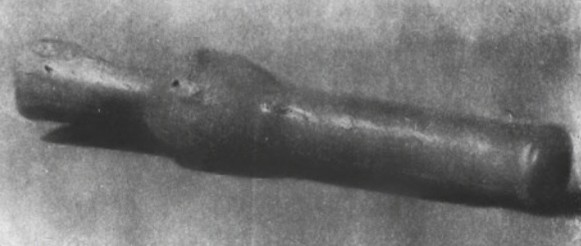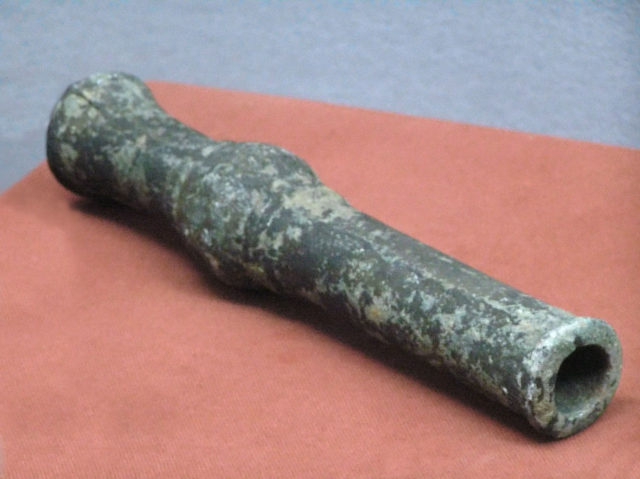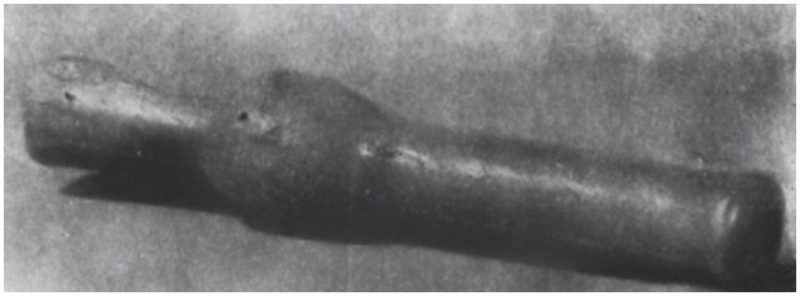The Heilongjiang hand cannon or hand-gun is a bronze hand cannon manufactured no later than 1288 and the world’s oldest surviving firearm. It weighs 3.55 kg (7.83 pounds) and is 34 centimeters (13.4 inches) long. The hand cannon was light enough that it could be carried on the backs of Yuan dynasty soldiers.
The Heilongjiang hand cannon was excavated during the 1970s in Banlachengzi, a village in the province of Heilongjiang in Manchuria. It was found alongside other bronze artifacts made in the style of the Jurchen Jin dynasty (1115–1234).
The hand cannon likely originates from battles fought nearby Banlachengzi in 1287 and 1288. The Yuanshi reports that a Jurchen commander led a group of soldiers carrying hand cannons into a military camp in 1288.
Gunpowder was invented in China in the 9th century. The Taoist alchemical book Zhenyuan miaodao yaolüe from the mid-800s contains a passage that mentions the use of gunpowder. By the 12th century, Song dynasty forces were fighting battles with gunpowder weapons such as fire lances, grenades, and metal bombards.
Exploding gunpowder bombs were used as early as 1126 during the Jingkang Incident, when the Jurchen Jin dynasty besieged the Song capital of Kaifeng. The Song launched explosive bombs called pili pao (霹雳炮) at the besiegers.
The ancestor of the cannon and hand cannon is the Chinese fire lance. The fire lance is a spear tied with a bamboo or paper barrel that could fire projectiles. The transition between the fire lance to the cannon or hand cannon was gradual, so literary references to a weapon called huotong (“fire tube”) can either denote fire lances or metal-barrel firearms.
The Xingjun Xuzhi (“What an Army Commander in the Field ought to Know”) dated 1230 lists huotong among other gunpowder weapons, but may refer to either a fire lance or a hand cannon. Nevertheless, archaeologists have discovered hundreds of surviving metal cannons and hand cannons in China from the 13th and 14th centuries.

The oldest of these excavated cannons is the Wuwei cannon dated 1227. It was discovered in Wuwei, Gansu and likely originates from the Western Xia period. The Wuwei cannon has a weight of 108.5 kilograms (239 pounds), a diameter of 12 centimeters (5 inches), and a length of 1 meter. An iron cannonball and a small quantity of gunpowder were also discovered at the Wuwei archaeological site.
The earliest cannon inscribed with its date of manufacture is a bronze cannon dated 1298 with an inscription in ‘Phags-pa script. Outside of archaeological finds, appearances of the cannon in Chinese art may suggest that the cannon was invented as early as the 12th century. The oldest artistic representation of a cannon is a stone relief sculpture dated 1128. The sculpture was discovered in 1985 carved in the walls of Cave 149 of the Dazu Rock Carvings in Dazu,Chongqing.
The Heilongjiang hand-gun dated 1288 is the earliest extant hand cannon. At 3.55 kg (7.83 pounds), it is considerably lighter than older gunpowder weapons such as the bulky trebuchets that were used to launch explosive bombs.Since the earliest textual reference to a hand cannon is dated 1230 and the oldest surviving hand cannon is dated 1288, the invention of the hand cannon likely occurred in the mid-13th century.
The invention of the metal-barrel hand cannon in China did not diminish the popularity of the earlier bamboo-barrel fire lances. The fire lance was cheaper and more portable than the hand cannon, so it was still used in China until the 16th century when the musket replaced the fire lance
The hand cannon was discovered in July 1970 at an archaeological site in Banlachengzi village. The village is situated on the shores of the Ashi River in the Acheng District of Heilongjiang, a province in Manchuria.
The archaeologists discovered several bronze objects that were excavated with the hand cannon. The excavated objects were a bronze vase, a bronze mirror, and a bronze cooking pan. All the bronze artifacts were manufactured in the style of the Jurchen Jin dynasty.
The Jin dynasty collapsed after the Mongols besieged and captured Caizhou in 1234, which suggests that the Heilongjiang hand-gun can reasonably be dated to the 13th century at the latest.
The dating of the Heilongjiang hand-gun is based on battles in 1287 and 1288 that were fought near the site where the archaeologists discovered the hand-gun. An account of the battles is given in the Yuanshi, a text that documents the history of the Yuan dynasty.
The Mongol prince Nayan allied with Kaidu in Central Asia and started a rebellion in Manchuria against Kublai Khan’s reign as emperor of the Yuan dynasty. Khublai personally commanded the forces that were sent to suppress Nayan’s rebellion in 1287. Marco Polo claimed that Khublai’s forces comprised 460,000 men, but a more realistic estimate is that the soldiers numbered in the tens of thousands.

An ethnically Jurchen commander by the name of Li Ting served under Khublai Khan during his campaign against Nayan. In 1287, Li Ting led a group of soldiers equipped with portable hand cannons into Nayan’s military camp.
The Yuanshi reports that the hand cannons not only “caused great damage,” but also caused “such confusion that the enemy soldiers attacked and killed each other.” The hand cannons were used again in the beginning of 1288. Li Ting’s “gun-soldiers” or chongzu were able to carry the hand cannons “on their backs” according to the Yuanshi.
The passage on the 1288 battle is also the first to coin the name chong for metal-barrel firearms. Chong was used instead of the earlier and more ambiguous term huo tong , which may refer to the tubes of fire lances, proto-cannons, or signal flares.
Wei Guozhong was the archaeologist who excavated and dated the cannon. He wrote a description of the archaeological find in the article “A Bronze Bombard Excavated at Banlachengzi in Acheng Xian in Heilongjiang Province,” which was published in 1973 for the journal Reference Materials for History and Archaeology.
It was Wei who proposed a connection between the hand cannon discovered in Banlachengzi and the nearby battle sites. The historian Joseph Needham remarked that Wei’s “find will long remain of capital importance, since it is the only metal-barrel hand-gun so far discovered which almost certainly belongs to the 13th century.
